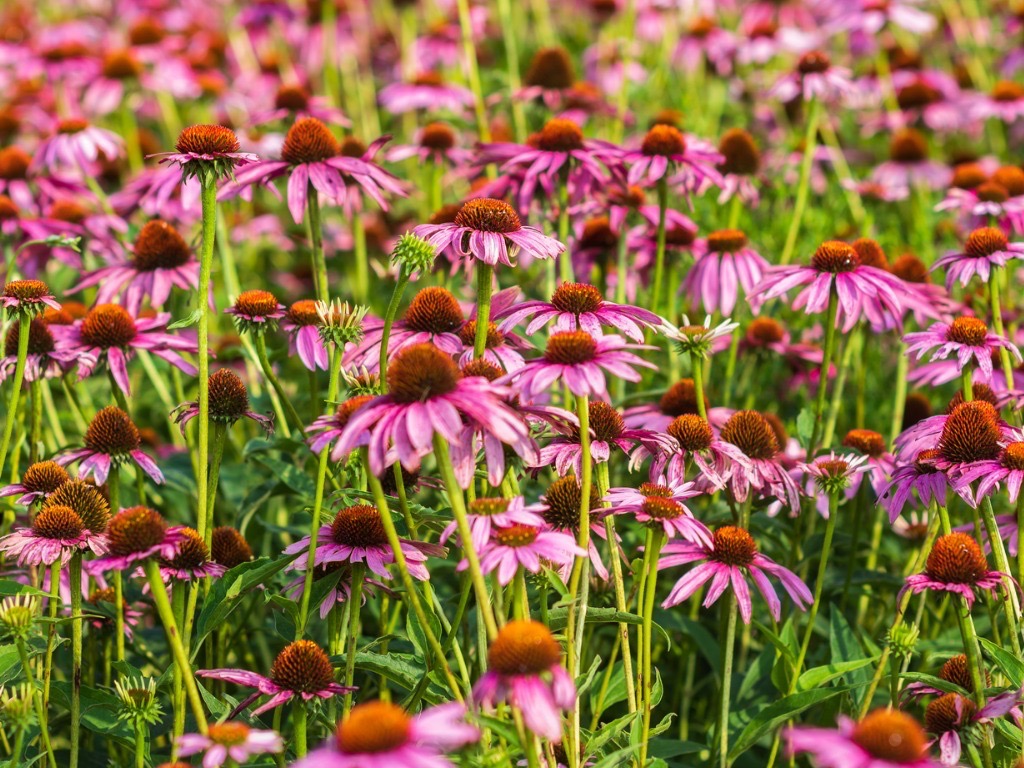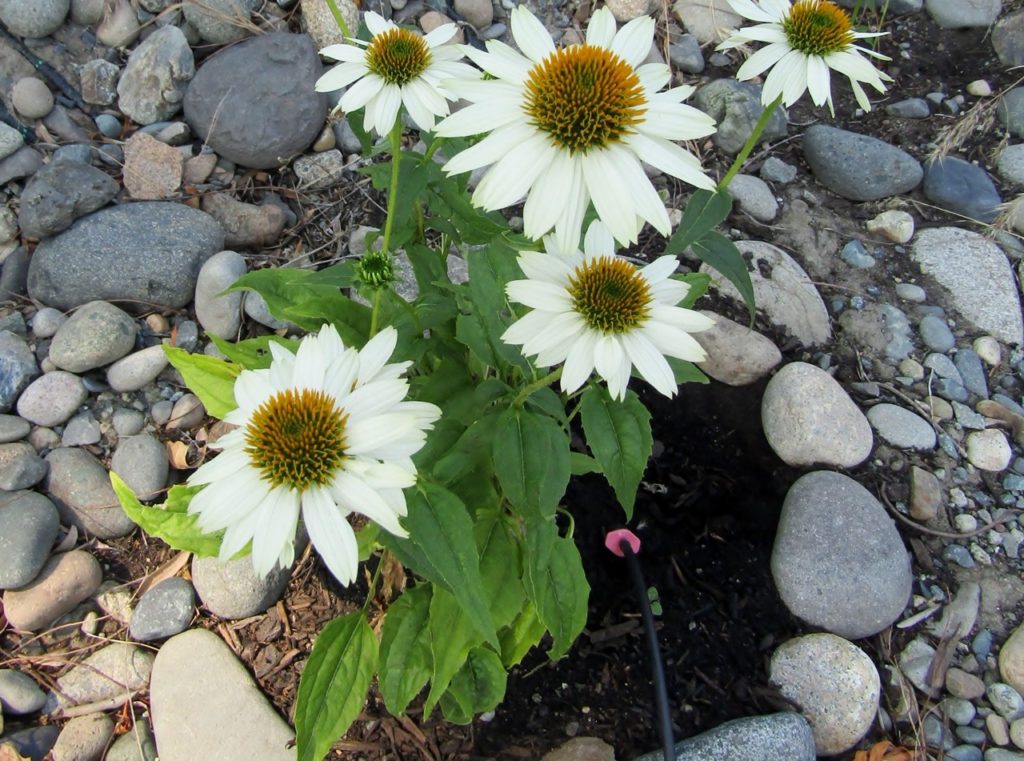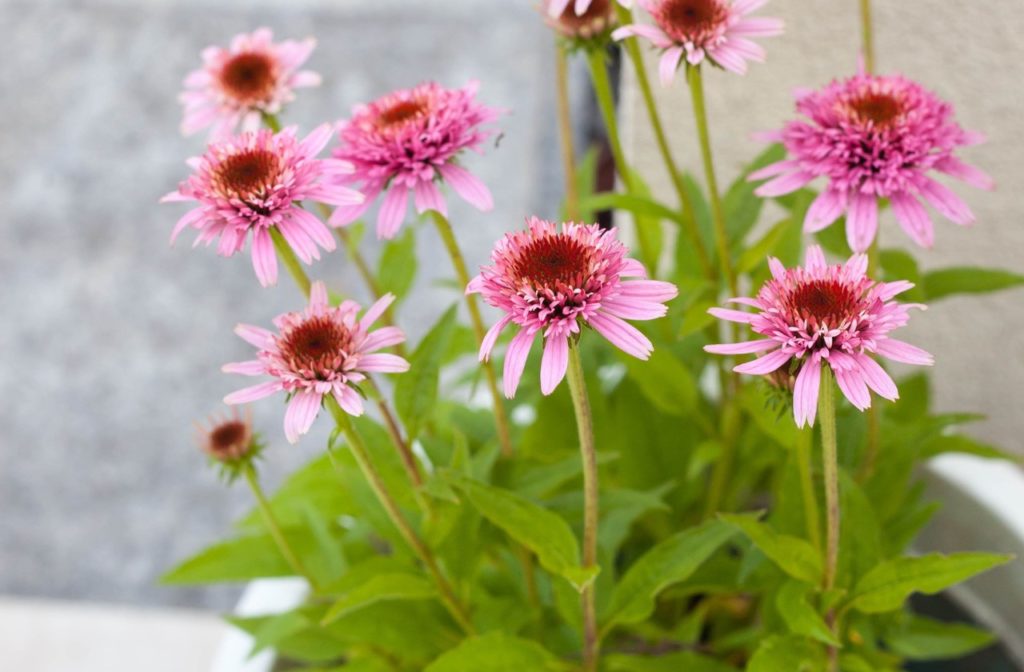PERENNIALS > ECHINACEA

Elizabeth is a Permaculture Garden Designer, Sustainability Consultant and Professional Writer, working as an advocate for positive change. She graduated from the University of St. Andrews with an MA in English and Philosophy and obtained a Diploma in Applied Permaculture Design from the Permaculture Association.
Reviewed By COLIN SKELLY

Colin is a Horticulturist and Horticultural Consultant with experience in a range of practical and managerial roles across heritage, commercial and public horticulture. He holds the Royal Horticultural Society’s Master of Horticulture award and has a particular interest in horticultural ecology and naturalistic planting for habitat and climate resilience.
ECHINACEA GUIDES
Echinacea purpurea is a well-known perennial which has gained in popularity in recent years with the growth of prairie planting schemes in the UK.
This North American prairie plant is an increasingly popular choice with UK gardeners, especially with those who wish to create an attractive prairie-style garden.
These plants will not suit particularly wet gardens, or those with heavier soils, but they can be a good choice for many gardens where there is a cool winter and a warmer spring.
They are relatively trouble-free and easy to care for, but make sure that you do not make any mistakes with positioning or care by reading this simple guide.
Overview
| Botanical Name | Echinacea purpurea |
| Common Name(s) | Purple Coneflower / Echinacea |
| Plant Type | Perennial |
| Native Area | Central and Eastern North America |
| Hardiness Rating | H5 |
| Foliage | Deciduous |
| Flowers | Daisy-like flower, often with pink petals |
| When To Plant | March-June |
| When To Prune | August-September |
Sunlight
Preferred
Full Sun or Partial Shade
Exposure
Exposed or Sheltered
Size
Height
1 – 1.5M
Spread
0.1 – 0.5M
Bloom Time
Summer
Soil
Preferred
Chalk, loam or sand
Moisture
Well-drained
pH
Any
E. purpurea, also known as purple coneflower, is a flowering perennial plant in the sunflower family.
It is native to parts of eastern North America, found in open woods and prairie landscapes.1Echinacea purpurea. (n.d.). Missouri Botanical Garden. Retrieved March 15, 2023, from https://www.missouribotanicalgarden.org/PlantFinder/PlantFinderDetails.aspx?kempercode=c580
This herbaceous perennial is also commonly grown in gardens.

One reason why the purple coneflower is so popular for gardens is that it is wonderful for attracting pollinators and other wildlife.
Bees and other pollinators love the pollen and nectar-rich flowers, and birds love the seeds.
Echinacea is also popular because it looks wonderful in naturalistic prairie planting schemes, alongside other herbaceous perennials and grasses, and these schemes have become very popular in recent years.
Common Varieties
E. purpurea traditionally comes in pink and occasionally white hues.
However, many modern hybrids have now been developed which come in a much wider range of colours, from yellows to oranges, to reds, to strong pinks and zingy greens.

Some of the new, named hybrid cultivars to consider include:
- E. purpurea ‘After Midnight’
- E. purpurea ‘Coconut Lime’
- E. purpurea ‘Fatal Attraction’
- E. purpurea ‘Fragrant Angel’
- E. purpurea ‘Green Envy’
- E. purpurea ‘Harvest Moon’
- E. purpurea ‘Kim’s Knee High’
- E. purpurea ‘Magnus’
- E. purpurea ‘Summer Sky’
- E. purpurea ‘Sundown’
- E. purpurea ‘Tikki Torch’
- E. purpurea ‘Tomato Soup’
- E. purpurea ‘Twilight’
- E. purpurea ‘White Swan’

Where To Plant
E. purpurea is typically sown in March or April and planted out in May or June.
It can also be potted up and placed in a greenhouse or other undercover growing area for its first season, before being planted out in spring or early summer the following year to make sure that the roots are well established.
When choosing where to plant echinacea, it is important to remember that these plants like a position in full sun, though they can also cope with partial shade.
They will thrive in any free-draining chalk, loam or sandy soil.

Echinacea will look great in beds or borders in a cottage or informal garden, in a prairie planting scheme, in wildlife-friendly gardens or in wildflower meadows.
They look particularly good with rudbeckia, asters, helenium and other North American perennials, and ornamental grasses, but can also be combined with many other flowering perennials.
It may be beneficial to create a perennial border close to your vegetable patch, where flowering perennials like echinacea will attract pollinators and other beneficial wildlife.
You might also consider planting echinacea in a dedicated perennial herb garden, alongside a range of other culinary herbs which like full sun and fairly fertile, free-draining conditions.
How To Plant
The seeds should be sown in seed trays or pots, only just covered, near the surface of a suitable seed starting medium.
Seeds should be sown at 20°C for the best results and should germinate within 2-3 weeks.

The seedlings should be pricked out and placed into individual pots once they are large enough to handle, and whether planted out while small or grown on, should be hardened off before they are planted outside to reduce transplantation shock.
E. purpurea can also be purchased as pot-grown plants and planted out in May or June.
Ongoing Plant Care
Soil Requirements
Remember that coneflowers like fertile, free-draining conditions.
In fact, this is one of the most important things, since they cannot tolerate waterlogging at all.

As long as the soil is suitably free-draining, these are generally relatively easy and trouble-free plants to grow.
Watering
Rainfall will usually be sufficient for these flowering plants.
However, you may need to water a little during particularly dry periods.
Of course, you will need to water when plants are first becoming established, when growing from seed and when growing on seedlings undercover.
Feeding & Fertilising
Echinacea will not usually need feeding, though it can be a good idea to mulch around these plants with organic matter, largely to reduce moisture loss in dry summer weather, but also to provide some slow-release fertility and improve the soil in the area over time.
Pruning
E. purpurea can be cut back after flowering to encourage further blooms.

However, later in the season, the seed heads should be allowed to form and should be left in place for autumn and winter as a boon to birds and other wildlife.
Propagating
As well as sowing E. purpurea from seed, mature plants can also be propagated by means of division in spring or autumn.
However, they do not like disturbance so this should be kept to a minimum.
Root cuttings can also be taken, and placed in a cold frame in October.
Common Pests & Diseases
Generally, echinacea are not particularly troubled by pests or diseases.

However, when grown from seeds, the young tender seedlings will require protection from slugs where these are a problem.
FAQs
Does Echinacea Come Back Every Year?
Echinacea is a perennial and will usually come back every year.
However, it has been found that some more contemporary cultivars do not overwinter successfully in particularly wet UK gardens.
“In UK conditions, Echinacea purpurea should be considered a short-lived perennial as it is unlikely to survive much beyond three years in a planting,” says Master Horticulturist Colin Skelly.
“If you wish for it to remain in your planting scheme then you will need to keep on propagating it from seed or division to replace any plants that die off.”
How Long Do Purple Coneflowers Bloom?
E. purpurea can bloom from June right through to September, offering a long blooming period.

This is one of the reasons why they can be a great value addition to a garden.
Do You Cut Back Echinacea?
Cut back earlier blooms to encourage further flowering, but at the end of the season, it is best to leave seed heads in place for the wildlife to enjoy.
References
- 1Echinacea purpurea. (n.d.). Missouri Botanical Garden. Retrieved March 15, 2023, from https://www.missouribotanicalgarden.org/PlantFinder/PlantFinderDetails.aspx?kempercode=c580

